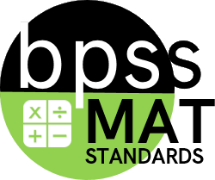BPS District Mathematics Standards Book
K-8 Grade Levels
Grade 07
Seventh Grade Math
"I can ... statements"
 In 7th grade, your child will grow in skill and understanding as he or she continues the previous grade’s work in proportional relationships, equations, and positive and negative numbers. These topics will remain a major emphasis throughout the
middle school years and into high school. A good command of rates and proportional relationships, including percentages, is also an important life skill.
In 7th grade, your child will grow in skill and understanding as he or she continues the previous grade’s work in proportional relationships, equations, and positive and negative numbers. These topics will remain a major emphasis throughout the
middle school years and into high school. A good command of rates and proportional relationships, including percentages, is also an important life skill.
MAT-07.RP Domain:
[RP] Ratios and Proportional Relationships
- MAT-07.RP.01 Compute unit rates associated with ratios of fractions, including ratios of lengths, areas and other quantities measured in like or different units.
- MAT-07.RP.02 Recognize and represent proportional relationships between quantities.
- MAT-07.RP.02.a Decide whether two quantities are in a proportional relationship by testing for equivalent ratios in a table or graphing on a coordinate plane and observing whether the graph is a straight line through the origin.
- MAT-07.RP.02.b Identify the constant of proportionality (unit rate) in tables, graphs, equations, diagrams, and verbal descriptions of proportional relationships.
- MAT-07.RP.02.c Represent proportional relationships by equations
- MAT-07.RP.02.d Explain what a point (x,y) on the graph of a proportional relationship means in terms of the situation, with special attention to the points (0,0) and (1,r) where r is the unit rate.
- MAT-07.RP.03 Use proportional relationships to solve multi-step ratio and percent problems.
MAT-07.NS Domain:
- MAT-07.NS.01 Apply and extend previous understandings of addition and subtraction to add and subtract rational numbers; represent addition and subtraction on a horizontal or vertical number
line diagram.
- MAT-07.NS.01.a Describe situations in which opposite quantities combine to make 0.
- MAT-07.NS.01.b Understand p + q as the number located a distance |q| from p on a number line, in the direction indicated by the sign of q. Show that a number and its opposite have a sum of 0 (are additive inverses). Interpret sums of rational numbers by describing real world contexts.
- MAT-07.NS.01.c Understand subtraction of rational numbers as adding the additive inverse, p ? q = p +(?q). Show that the distance between two rational numbers on the number line is the absolute value of their difference, and apply this principle in real world contexts.
- MAT-07.NS.01.d - Apply properties of operations as strategies to Fluently add and subtract rational numbers.
- MAT-07.NS.02 Apply and extend previous understandings of multiplication, division, and fractions to multiply and divide rational numbers.
- MAT-07.NS.02.a Understand that multiplication is extended from fractions to rational numbers by requiring that operations continue to satisfy the properties of operations, particularly the distributive property, leading to products such as (?1)(?1)=1 and the rules for multiplying rational numbers. Interpret products of rational numbers by describing real world contexts.
- MAT-07.NS.02.b Understand that integers can be divided, provided that the divisor is not zero, and every quotient of integers (with non-zero divisor) is a rational number. If p and q are integers, then ?(p/q) = ?p/q = p/?q. Interpret products of rational numbers by describing real world contexts.
- MAT-07.NS.02.c Apply properties of operations as strategies to Fluently multiply and divide rational numbers.
- MAT-07.NS.02.d Convert a rational number to a decimal using long division. Know that the decimal form of a rational number terminates or eventually repeats.
- MAT-07.NS.03 Solve real world and mathematical problems involving the four operations with rational numbers.
MAT-07.EE Domain:
[EE] Expressions and Equations
- MAT-07.EE.01 Apply properties of operations as strategies to add, subtract, factor, and expand linear expressions with rational coefficients with an emphasis on writing equivalent expressions.
- MAT-07.EE.02 Understand that rewriting an expression in different forms in a problem context can clarify the problem and how the quantities in it are related.
- MAT-07.EE.03 Solve multi-step real-life and mathematical problems posed with rational numbers in any form, using tools strategically. Apply properties of operations to calculate with numbers in any form. Convert between forms as appropriate. Assess the reasonableness of answers using mental computation and estimation strategies.
- MAT-07.EE.04 Use variables to represent quantities in a real world or mathematical problem, and construct simple equations and inequalities to solve problems by reasoning about the quantities.
- MAT-07.EE.04.a Solve word problems leading to equations of the form px + q = r and p(x + q) = r, where p, q, and r are specific rational numbers. Solve equations of these forms fluently. Compare the algebraic solution to an arithmetic solution, identifying the sequence
- MAT-07.EE.04.b Solve word problems leading to inequalities of the form px + q > r or px + q < r, where p, q, and r are specific rational numbers. Graph the solution set of the inequality and interpret it in the context of the problem.
MAT-07.G Domain:
- MAT-07.G.01 Solve problems involving scale drawings of geometric figures, including computing actual lengths and areas from a scale drawing and reproducing a scale drawing at a different scale.
- MAT-07.G.02 Draw geometric shapes from given conditions. Focus on constructing triangles from three measures of angles or sides, noticing when the conditions determine a unique triangle, more than one triangle, or no triangle. Use a variety of methods such as freehand, with ruler and protractor, and with technology.
- MAT-07.G.03 Describe the cross-sections (two-dimensional figures that result from slicing three-dimensional figures, as in plane sections) of right rectangular prisms and right rectangular pyramids.
- MAT-07.G.04 Know the formulas for the area and circumference of a circle and use them to solve problems. Informally derive the relationship between the circumference and area of a circle.
- MAT-07.G.05 Use facts about supplementary, complementary, vertical, and adjacent angles in a multi-step problem to write and solve equations for an unknown angle in a figure.
- MAT-07.G.06 Solve real world and mathematical problems involving area of two-dimensional figures composed of polygons and/or circles, including composite figures. Use nets to solve real world and mathematical problems involving surface area of prisms and cylinders, including composite solids. Solve real world and mathematical problems involving volumes of right prisms, including composite solids.
MAT-07.SP Domain:
[SP] Statistics and Probability
- MAT-07.SP.01 Understand that statistics can be used to gain information about a population by examining a sample of the population. Understand that generalizations about a population from a sample are valid only if the sample is representative of that population. Understand that random sampling tends to produce representative samples and support valid inferences.
- MAT-07.SP.02 Use data from a random sample to draw inferences about a population with an unknown characteristic of interest. Generate multiple samples (or simulated samples) of the same size to gauge the variation in estimates or predictions.
- MAT-07.SP.03 Informally assess the degree of visual overlap of two numerical data distributions with similar variabilities, measuring the difference between the centers by expressing it as a multiple of a measure of variability.
- MAT-07.SP.04 Use measures of center and measures of variability for numerical data from random samples to draw informal comparative inferences about two populations.
- MAT-07.SP.05 Understand that the probability of a chance event is a number from 0 through 1 that expresses the likelihood of the event occurring. Larger numbers indicate greater likelihood. A probability near 0 indicates an unlikely event, a probability around ╜ indicates an event that is neither unlikely nor likely, and a probability near 1 indicates a likely event.
- MAT-07.SP.06 Approximate the probability of a chance event by collecting data on the chance process that produces it and observing its long-run relative frequency. Predict the approximate relative frequency given the probability.
- MAT-07.SP.07 Develop a probability model and use it to find probabilities of events. Compare probabilities from a model to observed frequencies. If there is a discrepancy, explain possible sources.
- MAT-07.SP.07.a Develop a uniform probability model by assigning equal probability to all outcomes, and use the model to determine probabilities of events.
- MAT-07.SP.07.b Develop a probability model (which may not be uniform) by observing frequencies in data generated from a chance process.
- MAT-07.SP.08 Find probabilities of compound events using organized lists, tables, tree diagrams, and simulation.
- MAT-07.SP.08.a Understand that, just as with simple events, the probability of a compound event is the fraction of outcomes in the sample space for which the compound event occurs.
- MAT-07.SP.08.b Represent sample spaces for compound events using methods such as organized lists, tables and tree diagrams. For an event described in everyday language (such as rolling double sixes), identify the outcomes in the sample space which compose the event.
- MAT-07.SP.08.c Design and use a simulation to generate frequencies for compound events.
A Sample of What Your Child Will Be Working on in Grade 07
- Analyzing proportional relationships (e.g., by graphing in the coordinate plane), and distinguishing proportional relationships from other kinds of mathematical relationships (e.g., buying 10 times as many items will cost you 10
times as much, but taking 10 times as many aspirin will not lower your fever 10 times as much) - Solving percent problems (e.g., tax, tips, and markups and markdowns)
- Adding, subtracting, multiplying, and dividing positive and negative numbers, and solving related word problems
- Solving word problems that have a combination of whole numbers, fractions, and decimals (e.g., a woman making $25 per hour receives a 10% raise; she will make an additional 1⁄10 of her salary an hour, or $2.50, for a new salary of $27.50)
- Solving equations such as 1⁄2 (x – 3) = 3⁄4 quickly and accurately, and writing equations of this kind to solve word problems (e.g., “I knocked over a carton of milk, and 3 cups were spilled before I set the carton upright again. When I poured out the remaining milk equally into two measuring cups, there was 3⁄4 of a cup of milk in each one. How much milk was originally in the carton?”)
- Solving problems involving scale drawings
- Using statistics to draw inferences and make comparisons (e.g., deciding which candidate is likely to win an election based on a survey)
